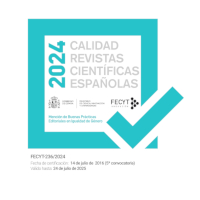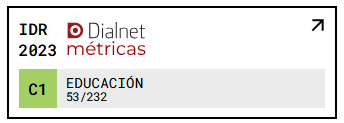Funciones y estrategias fundamentales de la guía-tutela entre iguales en las primeras edades
DOI:
https://doi.org/10.18172/con.402Abstract
In this work we displayed a theoretical frame on the peer guide-tutoring in the early ages. From a pluridimensional perspective we described its main characteristics, in contrast to the adult-child guide. We detailed the main patterns of organization of the guide and, finally, we made specific the characteristics of an effective position of a tutoring in these ages.Downloads
References
Azmitia, M. (1988): Peer interaction and problem solving: When are two heads better than one? Child Development, 59, 87-96.
Beaudichon, J., Verba, M. y Winnykamen, F. (1988): Interactions sociales et acquisition de connaissances chez l´enfant: Une approche pluridimentionnelle. Revue Internationale de Psychologie Sociale, 1, 130-141.
Bensallah, L. (1995): Dyades asymétriques et relations amicales entre enfants. Enfance, 1, 53-69.
Cazden, C. B. (1988): Classroom discourse. The language of teaching and learning. London: Routledge & Kegan Paul.
Cooper, C., Marquis, A. y Edward, D. (1986). Four perspectives on peer learning among elementary school children. En E. Mueller y C. Cooper (Eds.), Process and outcome in peer relationships (pp. 269-300). New York: Academic Press.
Ellis, S. y Rogoff, B. (1982): The strategies and efficacy of child versus adult teacher. Child Development, 53, 730-755.
Ellis, S. y Rogoff, B. (1986): Problem solving in children management of instruction. En E. C. Mueller y C. Cooper (Eds.), Process and outcome in peer relationship, (pp. 65-92). New York: Academic Press.
Forman, E. y Cazden, C. B. (1984): Exploring Vygotskian Perspectives in education: the cognitive value of peer interaction. En J. V. Wertsch (Comp.), Culture, communication and cognition: Vygotskian perspectives. Cambridge: Cambridge University Press, 139-157.
Fraysse, J. C. (1992): Relations entre développement cognitif et competénces interactives. Avalaible from The University of Provence, Aix en Prevence, France.
Gilly, M. (1980): Maître-élève. Rôles institutionnels et représentations. Paris: PUF.
Gilly, M. (1988): Interactions entre pairs et constructions cognitives: travaux expérimentaus de laboratoire au terrain pédagogique. European Journal of Psychology of Education, nº Hors série”Le functionnement de l´enfant à l´école: bilans et perspectives psychologiques et didactiques”, 127-138.
Gilly, M. (1989): The psychosocial mechanism of cognitive constructions. Experimental research and teaching perspectives. International Journal of Educational Rersearch, 13, 607-621.
Gilly, M. (1989b): A propos de la theorie du conglic socio-cognitif et des mecanismes psycho-sociaux des constructions: perspectives actuelles et modeles explicatifs. En N. Bednarz, y C. Garnier (Eds.) Construcions des savoirs: obstacles et conflits. Montreal: Agence d´ARC.
Hartup, W. W. (1989): Social relationships and their developmental significance. American Psychologist, 44, 120-126.
Pastor, E. y Sastre, S. (1994): Desarrollo de la inteligencia. En Bermejo, V. (Ed.): Desarrollo cognitivo. Madrid: Síntesis, pp. 191-213.
Roux, J. P. y Gilly, M. (1993): Social significance of task, routines, and pragmatic schemas in distribution activities. European Journal of Social Psychology, 23, 355-371.
Santolini, A., Danis, A. y Tijus Ch. A. (1996): Une méthode d´analyse des interactions cognitives dans l´environnement proximal du jeune enfant. Enfance, nº 3/1996, pp. 331-360.
Sastre, S. y Pastor, E. (en prensa): Desarrollo cognitivo y organización lógica de la acción: propuesta de análisis cualitativo en M.ª T. Anguera (Ed.), Metodología observacional en la investigación Psicológica. (Vol. 5) Barcelona: PPU.
Sastre, S. y Pastor, E. (1997): Desarrollo cognitivo e interacción asimétrica: notas para su estudio microgenético (en prensa).
Shute, R., Foot, H., y Morgan, M. (1992): The sensitivity of children and adults as tutors. Educational Studies, Vol. 18, 1, 2136.
Stambak, M. y Sinclair, H. (1993): Introduction. En M. Stambak y Sinclair, H. (Eds.): Pretend play among 3 years old. Hillsdale NJ: Erlbaum.
Verba, M. (1993): Cooperative Formats in Pretend Play Among Young Children. Cognition and Instruction, 11(3-4), 265-280.
Verba, M. (1993b): The construction and sharing of meanings in pretend play. E M. Stambak y H. Sinclair (Eds.). Pretend Play among 3 years olds. Hillsdale, New Jersey: Lawrence Erlbaum.
Verba, M. y Isambert, A. L. (1987): La costruzione delle conoscenze attraverso gli scambi tra bambini: Ruolo dei “Piu Vecchi” all’ interno del gruppo. En A. Bondiooli y S. Mantovani (Eds.): Manuale critico dell’asilo nido. (pp. 306-323). Milano: Franco Angeli.
Verba, M. & Winnykamen, F. (1992): Expert-Novice Interactions: Influence of Partner Status. European Journal of Psychology of Education.
Verba, M. (1994): The Begginins of Collaboration in Peer Interaction. Human Development, 37, 125-139.
Verba, M (1997): Interacció i desenvolupament cognitiu. Seminario celebrado en la URV (Tarragona), 16-1-1997.
Verba. M. (1998): Tutoring between young children: how simmetry can modify asimmetrical interactions. International Journal of Behavioral Development, Volume 22, Number 1, Marck 1998, 195-216.
Verba, M., Stambak, M. y Sinclair, H. (1982): Physical Knowledge and social interaction in children (from 18-24 months of age). En G. E. Forman (De.), Action and thought: From sensorimotor schemes to symbolic operation (pp. 267-296). New York: Academic Press.
Verba, M. y Isambert, A. L. (1987): La costruzione delle conoscenze attraverso gli scambi tra bambini: Ruolo dei “Piu Vecchi” all’ interno del gruppo. En A. Bondiooli y S. Mantovani (Eds.): Manuale critico dell’asilo nido (pp. 306-323). Milano: Franco Angeli.
Verba, M. y Marcos, H. (1995): Les interactions éducatives à l´âge préscolaire. Research report, Contrat MIRE, December, 1995.
Wertsch, J. V. y Hickmann, M. (1987): Problem solving in social interaction: A microgenetic analysis. En M. Hickman (Ed.) Social and functional approaches to language and though (pp. 251-266). Orlando, FL: Academic Press.
Wood, D. y Middleton, D. (1975): A study of assisted problem-solving. British Journal of Psychology, 2, 181-191.
Wood, D., Bruner, J.S., Ross, G. (1976): The role of tutoring in problem solving. Journal of Child Psychology and Psychiatry, 17, 89-100.
Downloads
Published
How to Cite
Issue
Section
License
The authors retain copyright of articles and authorize Contextos Educativos. Revista de Educación the first publication. They are free to share and redistribute the article without obtaining permission from the publisher as long as they give appropriate credit to the editor and the journal.
Self-archiving is allowed too. In fact, it is recommendable to deposit a PDF version of the paper in academic and/or institutional repositories.












